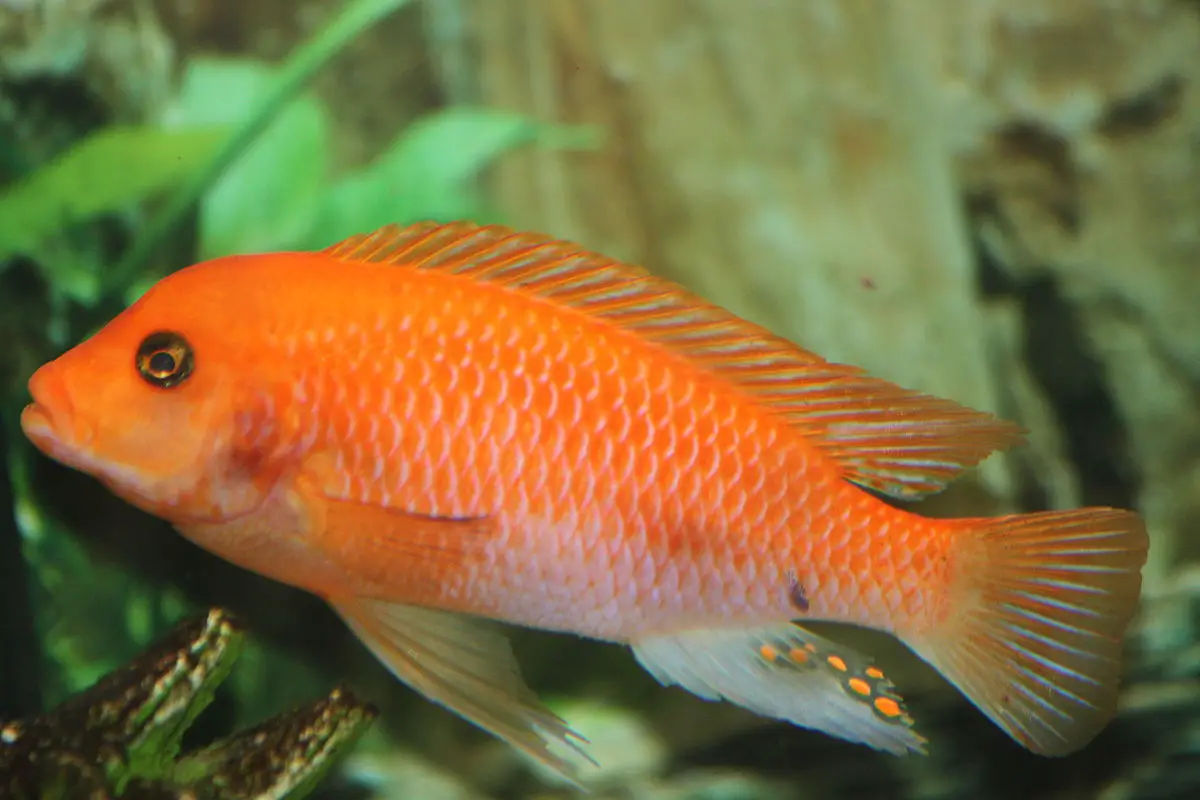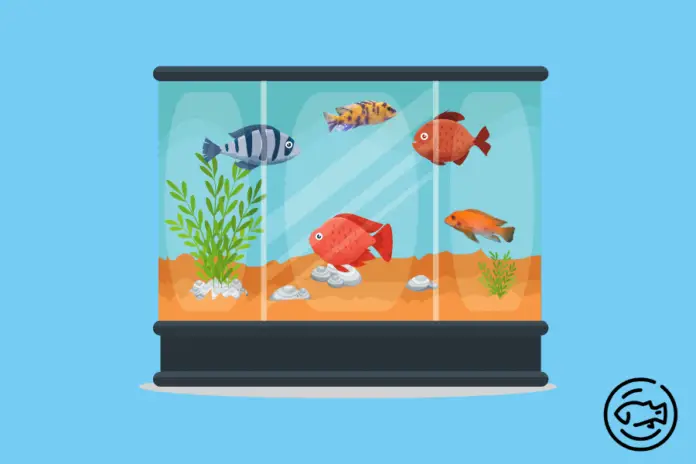The red zebra cichlid (Maylandia Estherae) is a tropical community fish known for its distinctive, bright coloration and semi-territorial tendencies.
This tropical fish is a popular choice among many home aquarium enthusiasts and is both relatively easy to supervise and fascinating to observe.
Despite its name, the red zebra cichlid comes in various colors, patterns, and appearances. Hobbyists interested in adding this fish to their tanks should take care of special considerations, including schooling, behavior, diet, and habitat needs.
In addition, red zebra cichlids, like many cichlids, can be susceptible to certain diseases.

These fish can create a lively and diverse tropical home aquarium with proper acclimation, tank planning, and routine maintenance.
Lifespan and Care
Red zebra cichlids live, on average, anywhere from 5 to 10 years in captivity.
During this time, they can extend up to 5 inches in length, which is slightly smaller than most cichlids. For context, African cichlids can reach up to 12 feet.
The red zebra cichlid is a smaller alternative to those interested in keeping the vivid, entertaining species.
This species is also a good jumping-off point for those interested in keeping slightly more advanced fish than the typical tetra or danio.
Appearance
 Courtesy of Maha Dinesh via Wikimedia
Courtesy of Maha Dinesh via Wikimedia
The most recognizable coloration of the red zebra cichlid is the orange-red one, which can be found in most local fish stores.
Many red zebra cichlids lack their distinctive stripes.
Instead, they are solid in appearance and often come in variations of blue, pink, yellow, and other colors.
However, wide varieties can be found with the zebra stripe banding.
Males and females are identical in appearance but can be told apart by their egg spots on the hind fins.
Males have 3 or more spots, whereas females have less than 3.
Habitat Requirements
While these cichlids are typically smaller, they still need an expansive tank. The ideal tank size should be a minimum of 55 gallons.
The tank should be large enough to accommodate a decent amount of aquascaping to provide shelter for the fish.
Red zebra cichlids, native to African lakes, prefer to hide in rocks and other structures. This is also a vital component of satisfying their territorial aggression.
A plethora of rocks and other structures should be provided to allow these cichlids to hide and declare their territory.
This will help reduce aggression, tank anxiety, and boredom.
Some red zebra cichlids can be observed “decorating” their tanks by moving around rocks and other decor items!
Water Requirements
The red zebra cichlid requires your average tropical water parameters.
The temperature should range from 72-82° Fahrenheit (22-28° Celsius). Warmer temperatures will cause faster metabolism in fish.
In terms of alkalinity, a slightly higher pH is ideal. 7.8 to 8.8 is a good standard, as these fish are accustomed to more alkalinity in the water.
Alkalinity can be raised using a commercial additive or baking soda in the water.
Finally, water hardness should range from 100 to 200 mg/l, as tropical fish prefer more challenging water.
These parameters are about the same for any tropical fish, so if you have an established tropical community tank, these fish should be compatible.
Schooling
These fish can be semi-territorial if you’re unfamiliar with the cichlid breed.
They can be kept successfully in large community aquariums, but only if certain conditions are met.
One necessary condition is that there are more females than males.
This will help reduce inter-species aggression and fighting. Another essential condition is having adequate space for cichlids to hide and play.
Over time, the cichlids will stake out an area as their territory, and as long as they don’t feel threatened, they won’t typically harm other fish.
Cichlids generally do well with more minor, peaceful fish and bottom feeders, like plecos.
Also read: 8 Best 55 Gallon Fish Tank Filter Reviews
Food and Diet
These cichlids shouldn’t ideally be fed a processed pellet diet.
Several cichlid foods are on the market, some of which claim to improve coloration. However, these foods are protein-rich and can lead to obesity in these fish.
Instead, cichlids mostly eat plant matter in their tanks. Having a well-planted tank is a must to keeping these fish.
They will nibble on the plants as they’re hungry, but you can supplement with small feedings or algae wafers daily just in case.
A mixture of plants will also help keep the tank’s nitrates low and provide ample hiding places.
Breeding
One reason why this species of fish is so widespread is because of their unique breeding process. These cichlids are maternal mouth brooders.
When a male fertilizes a spawn of eggs, the female will carry them in their mouth until they hatch and have absorbed their yolks.
She’ll continue to carry them until the fry is large enough to be released on their own. Until then, she’ll let them out sparingly to feed.
This unique ritual is a fascinating observance, but keep in mind that breeding these fish is more complex than one might think.
Health Concerns
 Courtesy of Davm76 via Wikimedia
Courtesy of Davm76 via Wikimedia
Red zebra cichlids are typically hardy fish, but extra concern should be given to prevent Malwai bloat, swim bladder disease, and common bacterial/fungal diseases like ich.
To prevent health issues in your community, maintain adequate water parameters and feed your fish a balanced diet.
Keep an eye out for lethargic or diseased fish and medicate as needed.
Adding Red Zebra Cichlids to Your Tank
These fish are incredibly interactive with one another, making them a worthy addition to your tank.
Not only that, but they come in various colors and patterns.
Their care is relatively straightforward, but extra attention must be paid to aquascaping to keep their aggression minimal.
Do you have any red zebra cichlids in your tank?
What’s your favorite thing about them? Let us know in the comments below.


